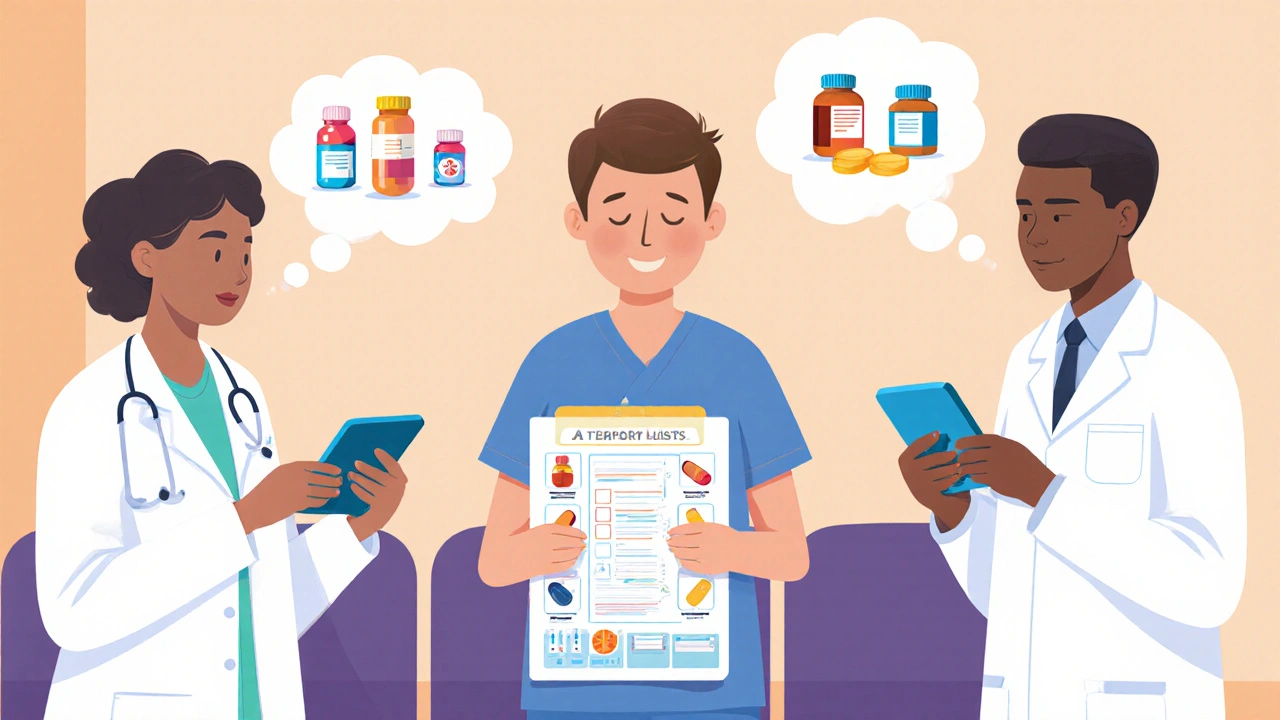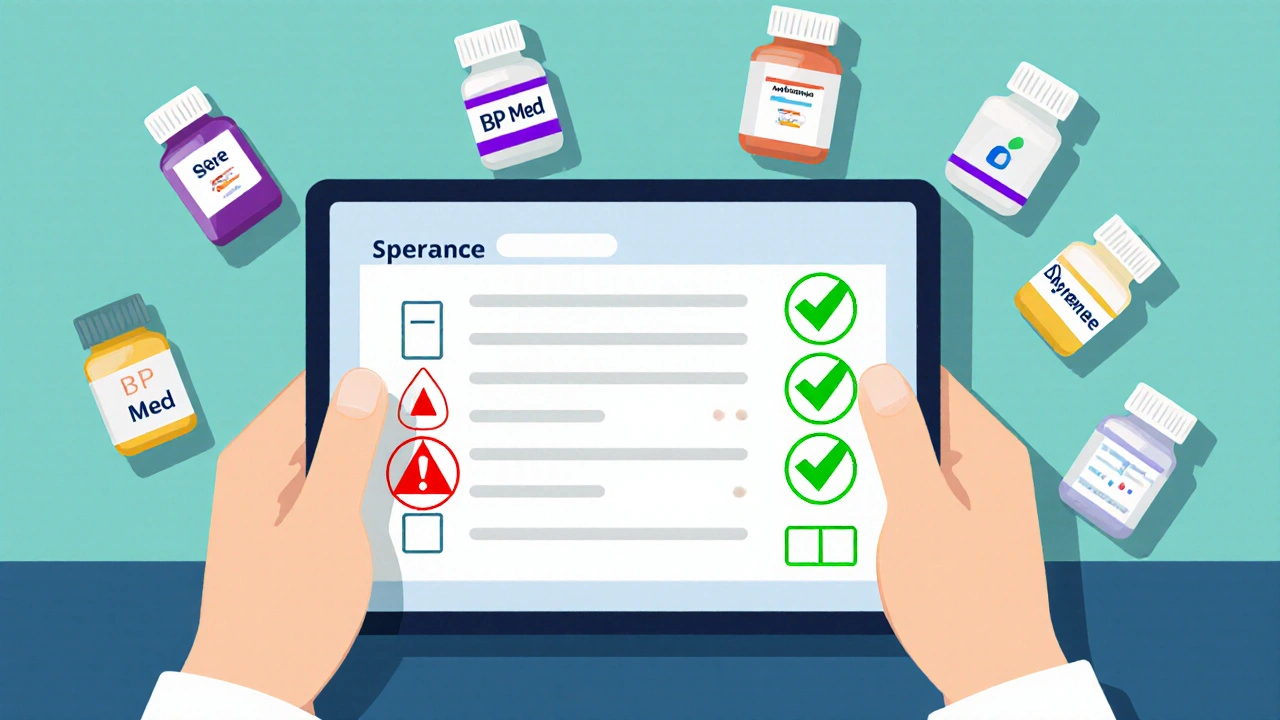
Imagine you’re seeing three different doctors for separate conditions. One prescribes a new painkiller, another adds a blood pressure pill, and a third gives you an antidepressant. None of them know what the others prescribed. You take them all-and end up in the emergency room because of a dangerous interaction. This isn’t rare. It happens more often than you think.
Why Medication Communication Breaks Down
When you see multiple providers, each one focuses on their area of expertise. A cardiologist treats your heart. A rheumatologist handles your arthritis. A neurologist manages your migraines. But rarely do they sit down together and talk about the full picture of your meds. That gap is where mistakes happen. Research shows that 68% of patients seeing multiple providers experience at least one medication-related error within a year. These aren’t just small slips-they’re life-threatening. In the U.S., medication errors cause over 1.5 million injuries annually and cost $3.5 billion in extra healthcare spending. In Australia, similar patterns exist, especially among older adults on five or more medications. The biggest problem? Providers often assume others are keeping track. A 2022 study found that 83% of patients believed their doctors were talking to each other about their meds. In reality, only 1 in 3 had any formal communication between providers.What a Complete Medication List Should Include
The single most powerful tool you have is a clear, up-to-date list of everything you take. Not just prescriptions-supplements, over-the-counter drugs, herbal remedies, even vitamins. A simple list can prevent half of all medication errors. Your list must have four key details for every medication:- Name (brand and generic, if applicable)
- Dosage (e.g., 10 mg, 500 mg)
- Frequency (e.g., once daily, twice a week, as needed)
- Purpose (why you’re taking it-e.g., "for high blood pressure," "for joint pain")
Who Should Be on Your Care Team
You’re not just a patient-you’re the captain of your care team. That team includes:- Your primary care provider-they should be your main point of contact for overall medication safety.
- Your pharmacist-they see all your prescriptions, spot interactions, and can flag duplicates or dangerous combos. Many pharmacies now offer free Medication Therapy Management (MTM) services.
- Specialists-they focus on specific conditions but often don’t know what others are prescribing.
- Nurses and care coordinators-especially in hospitals or ACOs (Accountable Care Organizations), they track transitions and reconcile meds.
- Family members or caregivers-they can help remember details, spot side effects, and speak up when something seems off.
How to Get Providers to Talk to Each Other
You can’t force doctors to communicate, but you can make it easier for them. Start by asking each provider: "Do you have access to my full medication history from other providers?" If they say no, say: "Can you please request my records from Dr. X’s office? I’ve brought my list with me." If you’re seeing providers in different health systems (e.g., one hospital and one private clinic), ask if they use the same electronic health record (EHR) system. If not, you may need to bring printed records or ask your primary doctor to send a summary. In Australia, Medicare’s My Health Record system is designed for this-but only 62% of patients actively use it. Make sure yours is updated. You can log in online and add your own medication list if providers haven’t.
Use the Teach-Back Method to Avoid Misunderstandings
Doctors give instructions fast. You nod along. But later, you’re confused. That’s why the Teach-Back Method works. After a provider explains a new medication, say: "Just to make sure I got this right-can you have me explain it back to you?" Then say it in your own words: "So I take this pill once a day, with food, to lower my cholesterol. If I feel dizzy, I should call you, not stop it." Studies show this cuts misunderstandings by 45%. It’s not about testing you-it’s about making sure the provider knows you understood. Most doctors appreciate it.Track Your Symptoms and Side Effects
Keep a simple journal. Note:- When you started a new med
- Any new symptoms (dizziness, nausea, rash, sleep changes)
- Changes in mood, energy, or appetite
- Missed doses or skipped pills
What to Do When a Specialist Prescribes Something New
Specialists often add meds without checking what’s already on board. A 2022 study found they initiated 41% of conflicting prescriptions. Next time a specialist prescribes something new, ask:- "Is this meant to replace one of my current meds, or is it in addition?"
- "Should I tell my GP about this?"
- "Are there any interactions with my other medications?"

How Long Does It Take to Get This Right?
Setting up good communication doesn’t happen overnight. It takes consistent effort over 3 to 6 months. Start small:- Make your medication list today.
- Bring it to your next appointment.
- Ask one provider if they’re aware of your other meds.
- Ask your pharmacist to review your list.
- Start your symptom journal.
What’s Changing in 2025
The healthcare system is slowly catching up. By 2025, 78% of independent pharmacies in Australia will offer formal Medication Therapy Management services. That means pharmacists will be legally allowed to review your entire regimen, contact your doctors, and adjust doses under protocols. AI tools are also emerging. At major hospitals, AI now scans your meds in seconds and flags dangerous combinations that humans might miss. One system at Mayo Clinic reduced review time from 15 minutes to under a minute. But tech alone won’t fix this. The real solution is you-being active, asking questions, and refusing to be silent.When to Get Help
If you’re taking five or more medications, see multiple specialists, or have had a recent hospital stay, you’re at higher risk. Don’t wait for a mistake to happen. Ask your GP for a referral to a medication management service. Many public hospitals and community health centres offer free reviews. If you’re on Medicare, you may qualify for a Medication Management Plan under the Chronic Disease Management program. You don’t need to be sick to get help. You just need to care enough to ask.What should I do if I think two of my meds are conflicting?
Don’t stop taking either one. Contact your pharmacist immediately-they’re trained to spot interactions and can advise whether it’s urgent. If it’s serious (e.g., dizziness, chest pain, confusion), go to an emergency department or call emergency services. Then, schedule a follow-up with your GP to review all your medications together.
Can my pharmacist really change my meds?
In Australia, pharmacists can’t prescribe new meds, but under the Medication Management Plan, they can recommend changes to your GP. They can suggest dose adjustments, stopping unnecessary drugs, or switching to safer alternatives. Your GP must agree, but pharmacists often have the data to back up their advice, making it easier for doctors to act.
Why do doctors keep prescribing new meds instead of stopping old ones?
It’s easier to add than to remove. Many providers don’t have a full view of your history, and stopping meds requires review, documentation, and follow-up. That’s why deprescribing-systematically reducing unnecessary medications-is now a key focus in geriatric care. Ask your doctor: "Is there a medication I can safely stop?"
How do I know if my electronic health record is up to date?
Log into your My Health Record (Australia) or equivalent system. Check if all your recent prescriptions and hospital visits appear. If something’s missing, ask your provider to upload it. You can also manually add your own list. Accuracy matters-over 40% of medication errors happen because records are outdated or incomplete.
What if my providers won’t talk to each other?
You have the right to request that your records be shared. Ask your GP to send a summary letter to your specialists, or request a care coordination meeting. If you’re in a hospital, ask for a care coordinator. If you’re still blocked, contact your local health advocate or patient rights office-they can help you navigate the system.

Post A Comment